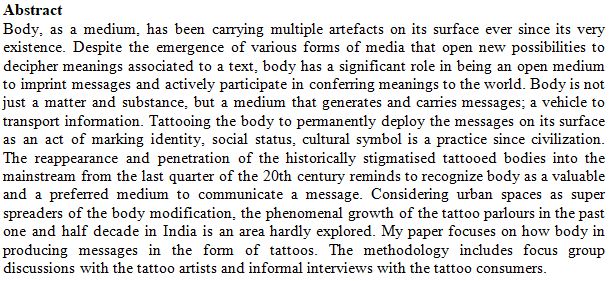Body as Medium: Exploring Body Images in Urban India (A Study on Hyderabad Tattoo Culture)
DOI:
https://doi.org/10.5281/zenodo.14760152Keywords:
body, tattoos, urban, culture, semioticsAbstract
Body, as a medium, has been carrying multiple artefacts on its surface ever since its very existence. Despite the emergence of various forms of media that open new possibilities to decipher meanings associated to a text, body has a significant role in being an open medium to imprint messages and actively participate in conferring meanings to the world. Body is not just a matter and substance, but a medium that generates and carries messages; a vehicle to transport information. Tattooing the body to permanently deploy the messages on its surface as an act of marking identity, social status, cultural symbol is a practice since civilization. The reappearance and penetration of the historically stigmatised tattooed bodies into the mainstream from the last quarter of the 20th century reminds to recognize body as a valuable and a preferred medium to communicate a message. Considering urban spaces as super spreaders of the body modification, the phenomenal growth of the tattoo parlours in the past one and half decade in India is an area hardly explored. My paper focuses on how body in producing messages in the form of tattoos. The methodology includes focus group discussions with the tattoo artists and informal interviews with the tattoo consumers.
Downloads
References
Atkinson, M. (2004). Tattooing and civilizing processes: Body modification as self‐control. Canadian Review of Sociology/Revue Canadienne de Sociologie, 41(2), 125–146. https://doi.org/10.1111/j.1755-618X.2004.tb02173.x.
Austin, I. (1992). City of legends: The story of Hyderabad. Viking. https://cir.nii.ac.jp/crid/1130000795482888960.
Das, D. (2015). Hyderabad: Visioning, restructuring and making of a high-tech city. Cities, 43, 48–58. https://doi.org/10.1016/j.cities.2014.11.008
Doss, K., & Ebesu Hubbard, A. S. (2009). The communicative value of tattoos: The role of public self-consciousness on tattoo visibility. Communication Research Reports, 26(1), 62–74. https://doi.org/10.1080/08824090802637072.
Gell, A. (1993). Wrapping in images: Tattooing in polynesia (Illustrated). Clarendon Press.
Jablonski, N. G. (2006). Skin a natural history. (Revised and Expanded ed). University of California Press.
Kosut, M. (2006a). An ironic fad: The commodification and consumption of tattoos. The Journal of Popular Culture, 39(6), 1035–1048. https://doi.org/10.1111/j.1540-5931.2006.00333.x.
Kosut, M. (2006b). Mad artists and tattooed perverts: Deviant discourse and the social construction of cultural categories. Deviant Behavior, 27(1), 73–95. https://doi.org/10.1080/016396290950677.
Kosut, M. (2015). Tattoos and body modification. in International Encyclopedia of the Social & Behavioral Sciences, pp. 32–38. Elsevier. https://doi.org/10.1016/B978-0-08-097086-8.64027-8.
Kraidy, M. M. (2013). The body as medium in the digital age: Challenges and opportunities. Communication and Critical/Cultural Studies, 10(2–3), 285–290. https://doi.org/10.1080/14791420.2013.815526.
Lévi-Strauss, C. (1963). Structural anthropology. (C. Jacobson & B. G. Schoepf, Trans.). Basic Books.
Madfis, E., & Arford, T. (2013). The dilemmas of embodied symbolic representation: Regret in contemporary American tattoo narratives. The Social Science Journal, 50(4), 547–556. https://doi.org/10.1016/j.soscij.2013.07.012.
Narendra, L. (1995, June 1). Narendra luther archives: "A replica of heaven". http://narendralutherarchives.blogspot.com/2006/12/replica-of-heaven.html.
Rees, M. (2016). From outsider to established—Explaining the current popularity and acceptability of tattooing. Historical Social Research, 41(3), 157–174.
Sarasin, P. (2007). The body as medium: Nineteenth-century european hygiene discourse. Grey Room, 29, 48–65. https://doi.org/10.1162/grey.2007.1.29.48.
Schildkrout, E. (2004). Inscribing the body. Annual Review of Anthropology, 33(1), 319–344. https://doi.org/10.1146/annurev.anthro.33.070203.143947.
Shusterman, R. (2008). Body consciousness: A philosophy of mindfulness and somaesthetics. (1st ed.). Cambridge University Press. https://doi.org/10.1017/CBO9780511802829.
Turner, T. S. (1980). The social skin. In J. Cherfasa & R. Lewin (Eds.), NotW orkA lone:A Cross-CulturVaile wo f Activities Superfluoutso Survival Not Work Alone: A Cross-Cultural View of Activities Superflous to Survival (pp. 112–140). Sage Publications.
Wirth, L. (1938). Urbanism as a way of life. American Journal of Sociology, 44(1), 1–24.

Published
How to Cite
Issue
Section
ARK
License
Copyright (c) 2025 Shiva Thrishul P, Tejasvi Jamjala

This work is licensed under a Creative Commons Attribution 4.0 International License.
Research Articles in 'Social Science Journal for Advanced Research' are Open Access articles published under the Creative Commons CC BY License Creative Commons Attribution 4.0 International License http://creativecommons.org/licenses/by/4.0/. This license allows you to share – copy and redistribute the material in any medium or format. Adapt – remix, transform, and build upon the material for any purpose, even commercially.










